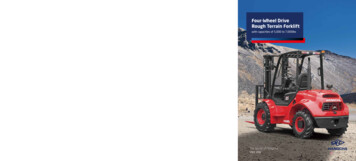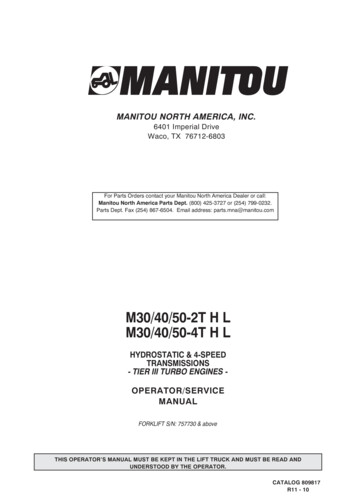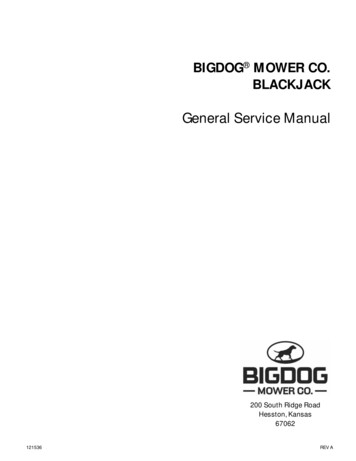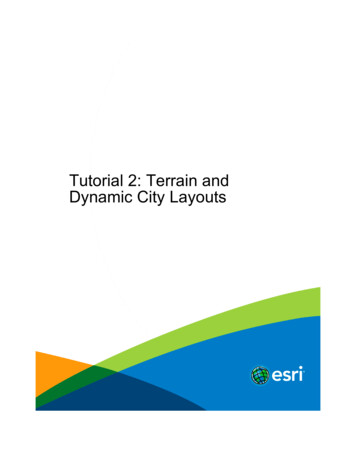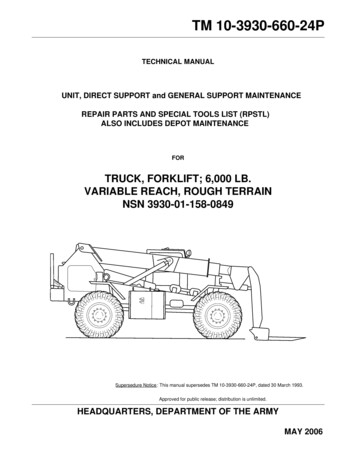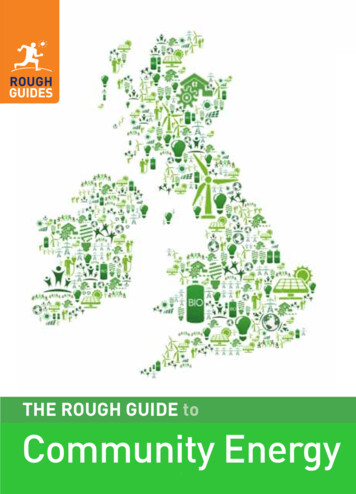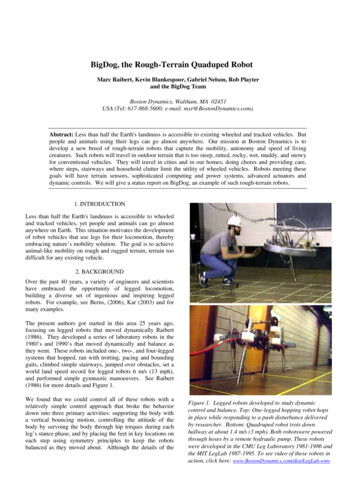
Transcription
BigDog, the Rough-Terrain Quaduped RobotMarc Raibert, Kevin Blankespoor, Gabriel Nelson, Rob Playterand the BigDog TeamBoston Dynamics, Waltham, MA 02451USA (Tel: 617-868-5600; e-mail: mxr@BostonDynamics.com).Abstract: Less than half the Earth's landmass is accessible to existing wheeled and tracked vehicles. Butpeople and animals using their legs can go almost anywhere. Our mission at Boston Dynamics is todevelop a new breed of rough-terrain robots that capture the mobility, autonomy and speed of livingcreatures. Such robots will travel in outdoor terrain that is too steep, rutted, rocky, wet, muddy, and snowyfor conventional vehicles. They will travel in cities and in our homes, doing chores and providing care,where steps, stairways and household clutter limit the utility of wheeled vehicles. Robots meeting thesegoals will have terrain sensors, sophisticated computing and power systems, advanced actuators anddynamic controls. We will give a status report on BigDog, an example of such rough-terrain robots.1. INTRODUCTIONLess than half the Earth's landmass is accessible to wheeledand tracked vehicles, yet people and animals can go almostanywhere on Earth. This situation motivates the developmentof robot vehicles that use legs for their locomotion, therebyembracing nature’s mobility solution. The goal is to achieveanimal-like mobility on rough and rugged terrain, terrain toodifficult for any existing vehicle.2. BACKGROUNDOver the past 40 years, a variety of engineers and scientistshave embraced the opportunity of legged locomotion,building a diverse set of ingenious and inspiring leggedrobots. For example, see Berns, (2006), Kar (2003) and formany examples.The present authors got started in this area 25 years ago,focusing on legged robots that moved dynamically Raibert(1986). They developed a series of laboratory robots in the1980’s and 1990’s that moved dynamically and balance asthey went. These robots included one-, two-, and four-leggedsystems that hopped, ran with trotting, pacing and boundinggaits, climbed simple stairways, jumped over obstacles, set aworld land speed record for legged robots 6 m/s (13 mph),and performed simple gymnastic manoeuvers. See Raibert(1986) for more details and Figure 1.We found that we could control all of these robots with arelatively simple control approach that broke the behaviordown into three primary activities: supporting the body witha vertical bouncing motion, controlling the attitude of thebody by servoing the body through hip torques during eachleg’s stance phase, and by placing the feet in key locations oneach step using symmetry principles to keep the robotsbalanced as they moved about. Although the details of theFigure 1. Legged robots developed to study dynamiccontrol and balance. Top: One-legged hopping robot hopsin place while responding to a push disturbance deliveredby researcher. Bottom: Quadruped robot trots downhallway at about 1.4 m/s (3 mph). Both robotswere poweredthrough hoses by a remote hydraulic pump. These robotswere developed in the CMU Leg Laboratory 1981-1986 andthe MIT LegLab 1987-1995. To see video of these robots inaction, click here: www.BostonDynamics.com/dist/LegLab.wmv
control varied from machine to machine, they all shared thesethree essential ingredients.hydraulic oil and a radiator cools the engine for sustainedoperation.Whereas the Leg Laboratory robots did a good job ofdemonstrated the feasibility of dynamically balanced leggedsystems, they had two primary limitations that would need tobe addressed to build practical legged vehicles. One is theneed for on-board power so the robot could operate in thefield without hoses and wires. Another is the need for controlalgorithms that provide locomotion and stability on roughterrain. We now turn to BigDog, a self-contained quadrupedrobot that uses many of the ideas and concepts of the LegLaboratory robots, but also addresses the practical problemsof onboard power and rough-terrain controls in order to movetoward practical legged vehicles.An onboard computer controls BigDog's behavior, managesthe sensors, and handles communications with a remotehuman operator. The control computer also records largeamounts of engineering data for performance analysis, failureanalysis and operational support.BigDog has about 50 sensors. Inertial sensors measure theattitude and acceleration of the body, while joint sensorsmeasure motion and force of the actuators working at thejoints. The onboard computer integrates information fromthese sensors to provide estimates of how BigDog is movingin space. Other sensors monitor BigDog's homeostasis:hydraulic pressure, flow and temperature, engine speed andtemperature, and the like.The onboard computer performs both low-level and highlevel control functions. The low-level control system servospositions and forces at the joints. The high-level controlsystem coordinates behavior of the legs to regulate thevelocity, attitude and altitude of the body during locomotion.The control system also regulates ground interaction forces tomaintain support, propulsion and traction.Figure 2. BigDog climbing a snow-covered hill duringtesting.To see BigDog in action, click this link:www.BostonDynamics.com/dist/BigDog.wmv.3. BIGDOGBigDog is a legged robot under development at BostonDynamics, with funding from DARPA. The goal is to buildunmanned legged vehicles with rough-terrain mobilitysuperior to existing wheeled and tracked vehicles. The idealsystem would travel anywhere a person or animal could gousing their legs, run for many hours at a time, and carry itsown fuel and payload. It would be smart enough to negotiateterrain with a minimum of human guidance and intervention.The BigDog robots we have built have taken steps towardthese goals, though there remains a great deal of work to bedone.BigDog has onboard systems that provide power, actuation,sensing, controls and communications. The power supply isa water-cooled two-stroke internal combustion engine thatdelivers about 15 hp. The engine drives a hydraulic pumpwhich delivers high-pressure hydraulic oil through a systemof filters, manifolds, accumulators and other plumbing to therobot’s leg actuators.The actuators are low-frictionhydraulic cylinders regulated by two-stage aerospace-qualityservovalves. Each actuator has sensors for joint position andforce. Each leg has 4 hydraulic actuators that power thejoints, as well as a 5th passive degree of freedom. See Figure3. A heat-exchanger mounted on BigDog's body cools theBigDog has a variety of locomotion behaviors. It can standup, squat down, walk with a crawling gait that lifts just oneleg at a time, walk with a trotting gait that lifts diagonal legsin pairs, trot with a running gait that includes a flight phase,and bound in a special gallop gait. Travel speed for the crawlis about 0.2 m/s, for the trot is about 1.6 m/s (3.5 mph), forthe running trot is about 2 m/s (4.4 mph) and BigDog brieflyexceeded 3.1 m/s (7 mph) while bounding in the laboratory.BigDog weighs about 109 kg (240 lbs), is about 1 meter tall,1.1 meters long, and 0.3 m wide.BigDog is usually driven by a human operator who worksthrough an operator control unit (OCU) that communicateswith the robot via IP radios. The operator uses the OCU toprovide high-level steering and speed input to guide the robotalong its path and to control the speed of travel. The operatorcan also tell the robot to start or stop its engine, stand up,squat down, walk, trot, or jog. A visual display provides theoperator operational and engineering data. The operator onlyprovides high-level input, leaving BigDog's onboard controlsystem to operate the legs, provide stability on rough terrain,and reflex responses to external disturbances.
Figure 4. Top: BigDog climbing 35 degree slope with loosescree-like surface. The front legs were reversed for thisexperiment. Bottom:.BigDog climbing a simulated rubblepile using a crawl gait in the laboratory. For thisexperiment, all terrain sensing is done with the legs, feelingits way along.We have integrated a stereo vision system and a LIDAR ontoBigDog. The stereo vision system was developed by the JetPropulsion Laboratory. It consists of a pair of stereocameras, a computer and vision software. The stereo systemcan be used to acquire the shape of the 3D terrain just in frontof the robot, and also to find a clear path forward. TheLIDAR is being used to allow BigDog to follow a humanleader, without requiring the operator to drive continuously.Figure 3. Illustration showing BigDog’s major components.We have tested BigDog travelling in mud and snow and oninclines with a variety of surfaces, including rutted trials,rocky, and loose scree. BigDog has also jumped about 1.1meters. and carried various loads. On flat terrain BigDog hascarried 340 lbs (154 kg), although loads of 50 kg are moretypical. We are working on a redesign of BigDog to climbwith larger loads.BigDog’s longest continuous operation was a 10 km hike (6.2miles) that lasted 2.5 hours. We are continually developingBigDog’s reliability, with an initial goal of 20 hours meantime to failure.4. CONTROLTo move at human-walking speeds, BigDog walks with adynamically balanced trot gait. It balances using an estimateits lateral velocity and acceleration, determined from thesensed behavior the legs during stance combined with theinertial sensors.BigDog’s control system coordinates the kinematics andground reaction forces of the robot while responding to basicpostural commands. The control distributes load amongst thelegs to optimize their load carrying ability. The verticalloading across the limbs is kept as equal as possible whileindividual legs are encouraged to generate ground reactionsdirected toward the hips, thus lowering required joint torquesand actuator efforts.Basic walking control uses the control system diagrammedbelow. A gait coordination algorithm, responsible for interleg communication, initiates leg state transitions to produce astable gait. A virtual leg model coordinates the legs.Figure 5: Control DiagramWe developed quadrupedal walking algorithms for inclinedand rough terrain and tested it in physics-based simulationbefore testing on the physical robot. See Figure 6. Thesimulated robot walks on inclines and declines with rockyslopes up to 60 degrees. It makes transitions from walkingon the level to walking on the incline or decline, and itaccommodates unexpected changes in terrain height causedby irregularities in the terrain, such as are caused by rocks.
The control system adapts to terrain changes through terrainsensing and posture control. The control system uses jointsensor information to determine when feet are in contact withthe ground and to determine the desired load on each leg andactuator. A posture algorithm controls body position bycoordinating the kinematics of the legs with the reactionforces of legs in contact with the ground. The posturealgorithm implements computed leg compliance on uneventerrain. This approach allows control of body roll, pitch, andheight relative to the ground, thereby allowing BigDog toadapt to local terrain variations without higher-level terrainsensing.BigDog adapts to the terrain in two ways. It adjusts bodyheight and attitude to conform to the local terrain, and itadjusts footfall placement to compensate for orientation ofthe robot body and ground plane relative to gravity. Thecontrol system leans the quadruped forward while climbingslopes, leans the body backwards while descending slopes,and leans it sideways while walking along the contour line.The control system accommodates shallow to moderateinclines by making slight adjustments to body posture, whileit accommodates inclines steeper than 45 degrees by alsoadjusting the walking gait pattern and using smaller steps.Many of these simulated results have been replicated on thephysical BigDog robot, except for very steep climbs wheretraction in the physical world limits performanceSelf Righting: BigDog has a significant ability to keep itsbalance when travelling on rough and irregular terrain,and when disturbed by outside forces. But we expectBigDog to fall over in the field, and it will need theability to right itself. We plan to add this ability to thenext version of BigDog.Quieter Operation: BigDog is a noisy robot, sounding like amotorcycle. There are several steps we plan to take toquiet BigDog: build a custom muffler, switch to fourstroke engine, enclose the engine and hydraulic pump,and possibly introduce optional hybrid power.More Autonomy: BigDog currently relies on a humanoperator to guide it through the terrain. But futureversions will use computer vision, LIDAR and GPS toprovide more autonomy. See Figure 7. We have alreadydone limited experiments in which BigDog uses LIDARto follow a human leader in open terrain and another inwhich BigDog travels to a sequence of pre-defined GPSlocations, without human intervention.Figure 7. Concept for autonomous cross-country operationguided by computer vision and/or LIDAR, without humanintervention. BigDog’s rough-terrain control and reflexeswill combine with terrain sensing to provide a high level ofautonomy.Figure 6: Image from physics-based simulation used todevelop walking algorithms.5. FUTURE PLANSThat is a snapshot of where BigDog stands today. While weare happy with the progress BigDog has made so far, muchhigher performance is possible and many practical problemsremain to be solved. Our immediate goals are to focus onfour areas:Rougher Terrain: Although BigDog is doing well on roughterrain, it should be possible to traverse rougher andsteeper terrain with more load. It will require amechanical design that is stronger and has larger rangesof limb motion.Advanced terrain sensing andlocomotion planning will also be needed to enable travelon rougher terrain.6. ACKNOWLEGEMENTSWe thank the members of the fantastic BigDog team who didall the hard work to make BigDog happen: Frank Agresti,Blake Brasher, Martin Buehler, Don Campbell, GuiCavalcanti, Benjamin Frank, John Giarratana, MikeGrygorcewicz, Malik Hansen, Alex Khripin, Chris Lee,David Leger, Mathew Livianu, Matt Malchano, PatrickMayeux, Neil Neville, Chris Richburg, Al Rizzi, Philip Rose,Aaron Saunders, Dane Saunders, Andrew String, ShervinTalebi. We also thank our partners at the Jet PropulsionLaboratory, Harvard University, and Great Lakes Sounds andVibration for their contributions. This work was sponsoredby the Defense Advanced Research Projects Agency, withadditional funding provided by the US Marine Corps and theUS Army.
6. REFERENCESBerns, K. (2006) Walking Machine Catalogue,http://www.walking-machines.org/.Kar, D. D., (2003) Design of Statically Stable WalkingRobot: A Review, J. Robotic Systems, 20(11):671-686.Raibert, M.H., (1986) Legged robots that balance, MIT Press,Cambridge MA.
goals will have terrain sensors, sophisticated computing and power systems, advanced actuators and dynamic controls. We will give a status report on BigDog, an example of such rough-terrain robots. 1. INTRODUCTION Less than half the Earth's landmass is accessible to wheeled and tracked vehicles, yet people and animals can go almost anywhere on .


